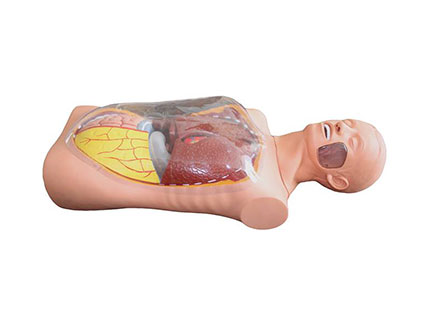Zhangjiagang Bailing Specimen Model Co., Ltd.
Contact:Mr Zhang
Eelephone:13506223680
Eelephone:18962473680
E-mail:cnbbmx@163.com
605340177@qq.com
Website:www.cnbbmx.com
Address:Bridge No. 4, Leyu Town, Zhangjiagang City, Suzhou City
Judgment index of cardiopulmonary resuscitation - medical human body model
(1) Appropriate judging indicators for cardiopulmonary resuscitation. According to the experience of most scholars and the actual level of cardiopulmonary resuscitation techniques, the following points are currently used as appropriate judging indicators for cardiopulmonary resuscitation. ① Corrected hypoxia and carbon dioxide accumulation. Return to normal or gradually approaching normal; ② blood pH tends to be normal; ③ no or little influence on circulatory function; ④ no damage to respiratory tract and lung parenchyma.
(2) Possible problems and countermeasures during CPR. At the beginning of CPR or during the whole period, some problems that interfere with CPR, affect the ventilation effect, or even cause serious complications may occur at any time, which should be accurately judged and dealt with in a timely manner. The incoordination of CPR and spontaneous breathing includes two aspects that are out of sync or confrontation. It can occur at any period of the CPR period, especially at the beginning of CPR or after a period of CPR, when the condition changes, the disturbance of consciousness is reduced. , more likely to occur when spontaneous breathing resumes.

(1) Reasons: ① Consciousness and shortness of breath patients do not understand the purpose of CPR, can not cooperate well or do not know how to cooperate; ② During the treatment process, patients have increased oxygen demand and excessive carbon dioxide production (such as fever) due to various reasons , decreased chest and lung compliance, increased airway resistance, increased work of breathing, etc.), relative or absolute hypoventilation, acidemia, carbon dioxide storage; ③ Pain stimulation, moving, sputum suction, abnormal central nervous system function or disturbance of consciousness Reduced, resulting in agitation and frequent coughing of patients; ④ changes in spontaneous breathing, respiratory weakness, abnormal respiratory rate and rhythm, pneumothorax, atelectasis, pulmonary embolism, bronchospasm, generalized convulsions; ⑤ CPR simulator trigger sensitivity Improper adjustment or malfunction, artificial airway is not smooth, the breathing loop is leaking, and the synchronization function cannot be triggered.
(2) The clinical manifestations of human-machine incoordination are characterized by abnormal operation of the emergency training simulator, and the airway pressure and tidal volume are unstable and disproportionate. When the airway pressure decreases, the tidal volume may increase relatively.
(3) In terms of human-machine incompatibility and harm to Hangzhou, if the work of breathing is increased and the circulatory burden is increased, not only can it not relieve hypoxia and carbon dioxide storage, but it will worsen it, and even cause shock and ventricular apnea, which is a favorable factor for cardiopulmonary resuscitation also turned into a negative factor.
(4) To deal with man-machine confrontation, the reasons should be identified first, and then corresponding measures should be taken for different reasons, which can be effective. The following are just a few examples of how to deal with the principles:
① The technique is excessively assisted breathing;
②Increase tidal volume or ventilation pressure;
③ Increase the concentration of inhaled oxygen;
④ Adjust the appropriate trigger sensitivity;
⑤ Relieve breathing circuit leakage and airway obstruction;
⑥ Change the appropriate ventilation mode;
⑦ Use analgesic or muscle relaxant drugs;
⑧ Instill lidocaine or dicaine into the trachea.
Common causes and treatments:
(1) When the tracheal tube is thinner for adults, when a tube with a diameter of 6.5 mm or less is used, if the tidal volume given is large, or the inspiratory flow rate is too fast, airway hypertension may occur. At this time, the impact on the patient will not be too great. It is necessary to appropriately prolong the inspiratory time, reduce the inspiratory flow rate, and try to control the airway pressure below 2.942kPa. If necessary, the thicker endotracheal tube can be replaced.
(2) The twisting and flattening of the tracheal tube can occur in any part of the tracheal tube, and the intraoral segment is more likely to occur. Adjusting the head position and the angle of the tracheal intubation or replacing the tooth pad can be relieved.
(3) The inflatable cuff loses its elasticity after aging, especially after over-inflation, the cuff is deflected to one side, which can make the oblique opening of the tracheal tube stick to the tracheal wall and cause obstruction. Choose a non-aging cuffed catheter, moderate inflation or adjust the depth of the catheter can be relieved.
(4) The installed tracheal tube cuff is too loose and slides to the oblique opening of the catheter, causing the oblique opening to be blocked after inflation. Complete or partial release of the cuff gas resolves the problem.
(5) Foreign body obstruction mainly includes sputum, blood, secretions, vomit and aspiration or other foreign bodies. Regular flushing of the suction endotracheal tube can prevent and clear blockages.
(6) When the tracheal tube is inserted too deeply into one side of the bronchus, it can also lead to increased airway pressure. While listening to the breath sounds, pull out the tracheal tube until the breath sounds are clear and symmetrical on both sides. Misdirected tracheal tube can also produce airway hypertension. It should be corrected immediately after identification.
(7) The chest and lung compliance decreases. If there is airway hypertension at the beginning of cardiopulmonary resuscitation, but the monthly tidal volume is not large, or the airway pressure gradually increases during the cardiopulmonary resuscitation process, the tidal volume decreases instead, and then combines ventilation and oxygenation. The index can judge the decrease of chest and lung compliance, and can also calculate chest and lung compliance through various monitoring values. Its treatment is mainly for the treatment of lung lesions.

Eelephone:13506223680 landline:0512-58961302
fax:0512-58961302 Website:www.cnbbmx.com
Address:Bridge No. 4, Leyu Town, Zhangjiagang City, Suzhou City
|
| |
cell phone station | WeChat public account |

